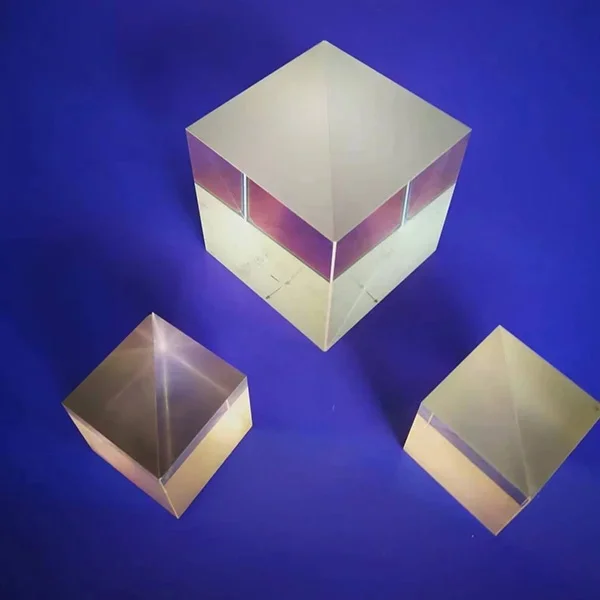Optical prisms are essential components in various optical systems, designed to manipulate light through refraction and reflection. These transparent polyhedra, typically made from glass or other clear materials, are utilized across multiple industries for their ability to split, bend, and direct light. At Yushen Optic-Electric, we specialize in manufacturing high-quality optical prisms, including our PBS1550nm model and various other types tailored for specific applications. This article will explore the different types of optical prisms and their diverse applications.

Understanding Optical Prisms
An optical prism is defined as a transparent object surrounded by two intersecting but non-parallel planes. The unique geometry of prisms allows them to alter the direction of light rays passing through them, making them invaluable in numerous optical applications. Prisms can be categorized based on their shape and function, including right-angle prisms, equilateral prisms, Dove prisms, pentagonal prisms, and more.
Types of Optical Prisms
1. Right-Angle Prism
Right-angle prisms are among the most commonly used types in optical systems. They have a 90-degree angle and are primarily used to reflect light at a right angle. These prisms can invert or rotate images, making them ideal for applications in telescopes and cameras.
Applications:
- Image rotation in optical devices
- Beam steering in laser applications
2. Equilateral Prism
Equilateral prisms have three equal sides and angles. They are primarily used for dispersing light into its constituent colors due to their ability to refract different wavelengths at varying angles.
Applications:
- Spectroscopy for analyzing light spectra
- Educational demonstrations of light dispersion
3. Dove Prism
Dove prisms are designed to rotate an image without inversion. They are commonly used in optical systems where image alignment is critical.
Applications:
- Telescopes and binoculars for image rotation
- Laser systems requiring precise beam manipulation
4. Penta Prism
Penta prisms have five sides and are used to reflect light at a 90-degree angle while maintaining the original orientation of the image. This makes them particularly useful in single-lens reflex (SLR) cameras.
Applications:
- Viewfinders in cameras
- Optical instruments that require image orientation without flipping
5. Dispersive Prism
Dispersive prisms are designed specifically to separate light into its component wavelengths. They exploit the principle of refraction to create a spectrum from white light.
Applications:
- Spectrometers for chemical analysis
- Optical sensors for detecting specific wavelengths
6. Roof Prism
Roof prisms consist of two right-angle prisms arranged to form a "roof" shape. They are used in binoculars and other compact optical devices to allow for a straight-line optical path while keeping the device compact.
Applications:
- Binoculars and monoculars
- Compact telescopes
7. Beam-Splitting Prism
Beam-splitting prisms divide a single beam of light into two or more beams. This function is essential in many scientific and industrial applications.
Applications:
- Interferometry for precision measurements
- Laser systems requiring beam division
Applications Across Industries
Optical prisms find applications in various fields due to their versatility:
1. Scientific Research
In laboratories, optical prisms are crucial for experiments involving light analysis, refraction, and dispersion. They are integral components in spectrometers and other analytical instruments.
2. Telecommunications
Prisms play a vital role in fiber optics by directing and manipulating light signals within communication systems, ensuring efficient data transmission.
3. Medical Devices
In medical imaging systems such as endoscopes, optical prisms help direct light to provide clear images of internal structures during procedures.
4. Entertainment Industry
In projectors and cameras, optical prisms help manage light paths to create high-quality images and effects essential for film production and presentations.
Why Choose Yushen Optic-Electric?
At Yushen Optic-Electric, we pride ourselves on offering high-quality optical prisms tailored to meet the specific needs of our clients:
- Customization Options: We provide product customization services for various parameters such as size, coatings, and materials.
- Quality Assurance: Our products undergo rigorous testing to ensure they meet international standards.
- Expertise: With years of experience in optics manufacturing, we offer technical support to help you select the right prism for your application.
- Diverse Product Range: From our PBS1550nm model to various other types like right-angle and penta prisms, we have solutions for every need.
Conclusion
Optical prisms are versatile tools that play a critical role in manipulating light across numerous industries. Understanding the different types of optical prisms and their applications can help you make informed decisions when selecting components for your optical systems.
At Yushen Optic-Electric, we are committed to providing high-quality optical solutions tailored specifically to your needs. Whether you require a standard prism or a customized solution, our team is here to assist you every step of the way.
For more information about our range of optical prisms or to discuss your specific requirements, please contact us today! Let Yushen Optic-Electric help you harness the power of optics in your projects.

